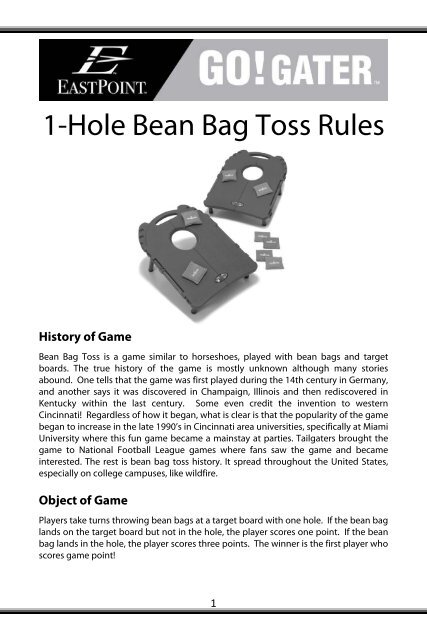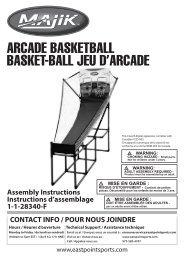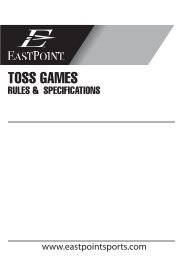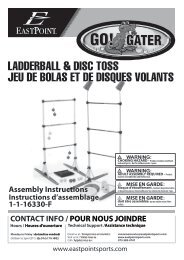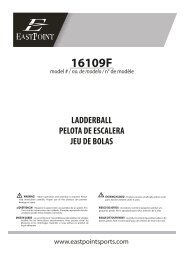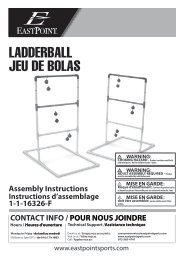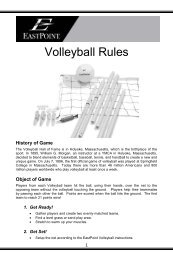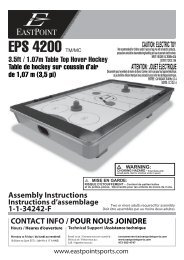1-Hole Bean Bag Toss Rules - EastPoint Sports
1-Hole Bean Bag Toss Rules - EastPoint Sports
1-Hole Bean Bag Toss Rules - EastPoint Sports
- No tags were found...
Create successful ePaper yourself
Turn your PDF publications into a flip-book with our unique Google optimized e-Paper software.
1-<strong>Hole</strong> <strong>Bean</strong> <strong>Bag</strong> <strong>Toss</strong> <strong>Rules</strong>History of Game<strong>Bean</strong> <strong>Bag</strong> <strong>Toss</strong> is a game similar to horseshoes, played with bean bags and targetboards. The true history of the game is mostly unknown although many storiesabound. One tells that the game was first played during the 14th century in Germany,and another says it was discovered in Champaign, Illinois and then rediscovered inKentucky within the last century. Some even credit the invention to westernCincinnati! Regardless of how it began, what is clear is that the popularity of the gamebegan to increase in the late 1990’s in Cincinnati area universities, specifically at MiamiUniversity where this fun game became a mainstay at parties. Tailgaters brought thegame to National Football League games where fans saw the game and becameinterested. The rest is bean bag toss history. It spread throughout the United States,especially on college campuses, like wildfire.Object of GamePlayers take turns throwing bean bags at a target board with one hole. If the bean baglands on the target board but not in the hole, the player scores one point. If the beanbag lands in the hole, the player scores three points. The winner is the first player whoscores game point!1
1. Get Ready! Before you begin, recruit one person (i.e., singles) or three people (i.e., twoteams) to play with you. Select a level playing area where your play will not impact other nearbyactivities. Consider safety first for all throwing games! Stretch to wake up your muscles!2. Get Set! Place the two target boards a convenient distance apart; 10 to 25 feetworks well for most game play. See Figure A. Pick teams, if playing with four people. <strong>Toss</strong> a coin to determine which player or team throws first. Assign a bean bag color to each player or team. Try a few warm up shots.Figure A:Go! Gater TM 1-<strong>Hole</strong> <strong>Bean</strong> <strong>Bag</strong> <strong>Toss</strong> Setup10 to 25 feet3. Go! Play Basic scoring rules:o Keep scores verbally during play for everyone to hear.o Invisible foul lines exist from the edge of each target box. Players maynot cross this line when throwing. These “foot fouls” result in the lossof that throw and any score it may have gained.o Back up so that you stay behind the front edge of each target board ifyou need more room to wind up and throw, to avoid foot fouling.o <strong>Bean</strong> bags landing on the target board or in the hole that werethrown during a foot foul must be removed from the playing area.o <strong>Bean</strong> bags lying on top of the target board which are knocked intothe hole by a foul bean bag must be returned to their original scoringposition before play can resume.o Any bean bag that leaves a player’s hand once the arm swings countsas a throw.o <strong>Bean</strong> bags thrown in the hole score three points each. They must betotally inside the hole to count.o <strong>Bean</strong> bags landing on top of the target board or hanging into the2
ooohole, but not in the hole, score one point each.<strong>Bean</strong> bags thrown on the ground or out of the playing area, scorezero points each.Similar to horseshoes, bean bags for opposing players on a givenround cancel one another out.Any throws that bounce off tree limbs or any other obstructions areconsidered foul, and receive no score. Game play:o In singles play, players walk back and forth between target boardstogether as play unfolds. For team play, players split up, with onemember at each target board, similar to horseshoes.o Winner of the coin toss pitches all their bean bags to the target boardon the opposite end, and waits for the opponent to throw. After thefirst round, players and teams alternate who goes first.o In singles play, once all the bean bags have been thrown, the twoopponents walk down to the target board and tally any points thatwere made. Once scoring for that round is decided and tallied, bothplayers will continue playing towards the other target board,repeating this process until one player wins the game.o In team play, players from both teams take turns to throw their beanbags to the other target board where their teammates are waiting.When these throws are complete, the other two players will mutuallydecide on the scores. When this first round is scored, play begins inthe opposite direction. The first two players who initially threw willnow watch game play, and score the incoming bean bags.o Work out any score discrepancies before continuing play.o Play continues until the game point of 21 is reached. If scores are tiedat 21, play one more round. Winner of the next round, wins the game.Game VariationsEasier GameEliminate the foul line rule from the game. This is one less rule to follow and makesplaying with inexperienced, special-needs, or young players easier. Also to make thisgame easier, shorten the distance between target boards. Everyone can enjoy thiswonderful game!Game TriviaDo you know these bean bag toss terms? Blocker - A bean bag that lands in front of the hole blocking the hole fromsliding bean bags who might have otherwise made it in the hole. Frame - When both players throwing their four bean bags. After each3
player has thrown four bean bags, the score is calculated and a new framebegins.Gusher or Double Deuce - Four holes made by a single player in a singleframe.Leprechaun - When a player attains all four bags onto the board withoutgetting any into the hole.Power Wash -A round in which all four bags from each opposing playerland on the board, causing the round score to be zero, a wash.Pressure Cooker - When both players on one end continually negate eachothers scores thus creating a very tense situation.4
Règlements de jeu depoches à 1 trouL’histoire du jeuLe jeu de poches est semblable aux fers à cheval, joués avec des poches et despanneaux cible. La vraie histoire du jeu est inconnue bien que plusieurs histoiresexistent. On dit que le jeu a été d'abord joué pendant le 14 ème siècle en Allemagne etun autre dit qu'on l'a découvert à Champaign, l'Illinois et ensuite redécouvert auKentucky dans le dernier siècle. Certains même créditent l'invention à Cincinnati del’ouest. De toutes façons, c’est clair que la popularité du jeu a augmenté à la fin desannées 1990 dans des universités de Cincinnati, spécifiquement à l'Université deMiami où ce jeu est devenu un standard aux fêtes. Aux fêtes d’avant-match de laNational Football League les partisans on vu le jeu et sont devenus intéressés. Onconnaît la suite du jeu de poche. Il s'est répandu aux Etats-Unis, particulièrement surdes campus d'université, comme une traînée de poudre.Le but du jeuLes joueurs alternent lancer des poches au panneau cible avec un trou. Si la poche serepose sur le panneau cible, mais n’entre pas dans le trou, le joueur marque un point.Si la poche entre le trou, le joueur marque trois points. Le victoire est le premier joueurqui marque les plus des points.5
1. Préparez-vous Avant de commencer, recrutiez une personne (c-à-d, jeu simple) ou troispersonnes (c-à-d, jeu d’équipe) pour jouer. Choisissez un endroit de niveau qui n’aura pas l’impact aux autres activitésproches. Considérez la sécurité avant tout pour tous les jeux de lancer. Etirez-vous pour réveiller vos muscles.2. Prêt. Placez les deux panneaux cibles à une distance commode : de 3 à 7,6 m(10 à 25 pi) à part, bon pour la plupart des parties. Voir la figure A. Choississez les équipes, si vous jouez avec quatre personnes. Tirez à pile ou face pour déterminer le joueur, en jouant avec deuxpersonnes, ou l'équipe qui commencera le jeu. Assignez une couleur de poche à chaque joueur ou équipe. Essayez quelques lancers d’échauffement.Figure A:Disposition de jeu de poches à 1 trou Go! Gater TM3 à 7,6 m (10 à 25 pi)3. Jouez. Règlements de base :o Comptez les points verbalement pendant la partie pour que tout lemonde puisse l’entendre.o Une ligne de jeu invisible existe devant le bord de chaque cible. Lesjoueurs ne peuvent pas traverser cette ligne en lançant. Ces « fautesde pied » annulent le lancer et tout pointage qu'il pourrait marqué.o Marchez en arrière pour rester derrière la ligne de jeu de chaquepanneau cible s’il vous faut plus d’espace pour lancer, pour éviter lafaute de pied.o Les poches qui atterrissent sur le panneau cible ou entrent dans letrou qui ont été lancées lors d’une faute de pied doivent êtreenlevées du jeu.o Les poches qui restent sur le panneau cible après avoir été mises dansle trou par une poche de faute doivent être rendues à leur positionoriginale avant que la partie ne puisse reprendre.o Toute poche quittant la main d'un joueur après que le joueur6
ooooocommence lancer compte comme un lancer.Les poches entrant dans le trou marquent trois points chacun. Ellesdoivent être complètement à l'intérieur du trou pour être valide.Les poches qui atterrissent sur le panneau cible ou suspendent dansle trou, mais n’entrent pas dans le trou, marquent un point chacun.Les poches lancées sur le terrain ou hors des limites ne marquentaucun point.Semblable au pointage de fers à cheval, les poches des joueursadversaires s’annulent dans chaque partie.Tout lancer qui rebondit contre des branches ou des autresobstructions sont des fautes et ne reçoit aucun point. La partie :o Les joueurs de match simple marchent dans les deux sens entre lespanneaux cibles lorsque le match se déroule. Dans les matchsd’équipe, les coéquipiers se séparent, avec un membre derrièrechaque panneau, semblable aux fers à cheval.o Le gagnant du tir de pièce de monnaie lance toutes les poches aupanneau cible au côté opposé et attend que l'adversaire lance. Aprèsla première partie, les joueurs ou les équipes alternent lancer audébut.o Dans le jeu simple, une fois toutes les poches ont été lancées, lesdeux adversaires marchent au panneau cible et totalizer le pointagedes poches marquantes. Après avoir décider le pointage, les deuxjoueurs continueront à jouer vers l'autre panneau cible, répétant ceprocessus jusqu'à ce qu'un joueur gagne le jeu.o Dans le jeu d'équipe, les joueurs des deux équipes alternent lancer lespoches à l'autre panneau cible où leurs coéquipiers attendent. Aprèsces lancers, les deux autres joueurs décideront mutuellement lepointage. A la fin de la première partie, la prochaine partiecommencera dans la direction opposée. Les deux premiers joueursqui ont initialement lancé les poches maintenant observeront lapartie et marqueront les poches qui arrivent.o Résoudrez toute contradiction de pointage avant de continuer jouer.o Les parties continuent jusqu'à ce qu’un joueur ou une équipe marque21 points. Dans le cas d'un match terminé à égalité, jouez une partiede plus. Le victoire de la partie suivante serait le victoire du match.Variations de jeuPartie plus facileÉliminez le règlement de la ligne de jeu. C'est un règlement de moins et rend plusfacile le jeu avec des personnes de besoins inexpérimentés et spéciaux, ou avec desjeunes. Aussi pour le render plus facile, raccourcissez la distance entre les panneauxcibles. Tout le monde peut s’amuser avec ce merveilleux jeu.7
Fait anecdotiqueConnaissez-vous ces termes du jeu de poches ?Blocker – une poche qui atterrit devant le trou bloquant le trou des pochesqui pourraient autrement entrer dans le trou.Manche – après le lancer de toutes les poches par les deux joueurs, lepointage est calculé et une nouvelle manche commence.« Gusher » ou « Double Deuce » – un joueur fait enter ses quatre pochesdans le trous d’une manche.Lutin – un joueur lance quatre poches qui reposent sur le panneau sansentrer dans le trou.« Power Wash » (nettoyer haute-pression) – une partie dans laquelle toutesles quatre poches des joueurs atterrissent sur le panneau. Elles s’annulentdonc le pointage est zéro, partie nulle.Marmite en ébullition – les joueurs adversaires ne marquent aucun point,s’annullant les poches à plusieurs reprises et créant ainsi une situation trèstendue.8


